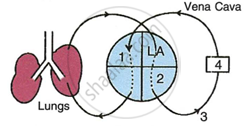Advertisements
Advertisements
प्रश्न
Given diagram is a schematic representation of the circulatory system in humans. Study the same and answer the questions that follow:
 |
- Label the parts 1 and 4 indicated in the diagram.
- Which of the above mentioned number is the thickest artery? Also write its name.
- Mention the number and chamber of the heart which has the thickest muscular wall.
- Which of the above numbers/structures has the maximum number of blood capillaries?
- Draw neat and labelled diagrams of the transverse section of vena cava and the part numbered as 3. Make sure to show the structural differences between these two in the diagram.
उत्तर
-
- Right auricle
- Left ventricle
- Aorta
- Body organs
- Number 3 is the thickest artery. The artery's name is Aorta.
- Number 2 has the thickest muscular wall, which is the left ventricle.
- The small intestine has the maximum number of blood capillaries.

संबंधित प्रश्न
The cells in our blood which destroy disease-causing germs are:
What is Diapedesis?
what is Lymph nodes?
Explain with reasons.
Human blood is red coloured.
Put a tick mark (✓) against the correct alternative in the following statement.
Pulmonary vein carries
Agranulocytes are about ______ % of total WBCs.
A resting person usually has a pulse rate between 72 to 80 beats per minute.
Given below are four statements regarding human blood circulatory system:-
- Arteries are thick walled and have narrow lumen as compared to veins.
- Angina is acute chest pain when the blood circulation to the brain is reduced.
- Persons with blood group AB can donate blood to any person with any blood group under ABO system.
- Calcium ions play a very important role in blood clotting.
Which two of the above statements are correct?
Name these:
Two kinds of circulatory systems in different animals.
The valve which prevents back flow of blood in the veins and lymph vessels is ______.
